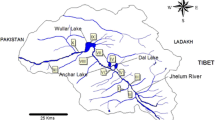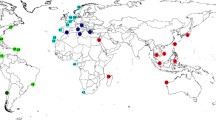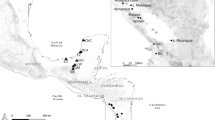Abstract
Using sequence analyses of fragments of the small and large subunits of mitochondrial genes 12S and 16S rRNA, we studied the molecular identity of five Triops populations from the Baja California Peninsula, México. Additionally, we explored the phylogeny of the genus by comparing with sequence data from gonochoric T. longicaudatus (Zacatecas, México), commercial Triops kit (U.S.A.), T. `granarius' (Japan), T. cancriformis (Austria), T. australiensis (Australia) and Lepidurus lemmoni (U.S.A.). The 16S fragment was not useful to discriminate the American Triops forms because their sequences were more than 99% similar. Molecular and phylogenetic analyses using the 12S gene fragments, in agreement with previous allozyme studies, indicate that the nominal (morphological) species T. longicaudatus is a mixture of several species such that, of the seven Triops American populations studied, six phylogenetic species can be identified and two morphologically and reproductively highly divergent forms can be grouped into a single monophyletic clade. The molecular data, rather than supporting our previous proposal that the phylogenetic relationships of Triops species could be deduced by similarities in the number of total and legless rings, suggest that T. cancriformis may represent an independent group from the rest of the species in that genus. In spite of detectable differences among American populations, our analyses indicate these represent a single monophyletic group when compared to Triops from outside of the New World.
Similar content being viewed by others
References
Avise, J. C., J. Arnold, R. M. Ball, E. Bermingham, T. Lamb, J. E. Neigel, C. A. Reeb & N. C. Saunders, 1987. Intraspecific phylogeography: the mitochondrial DNA bridge between population genetics and systematics. Ann. Rev. Ecol. Syst. 18: 489–522.
Cabot, E., 1998. The Eyeball Sequence Editor. Version 3.2 (c).
Colbourne, J. K. & P. D. N. Hebert, 1996. The systematics of North American Daphnia (Crustacea: Anomopoda): a molecular phylogenetic approach. Phil. Trans. r. Soc. Lond. B 351: 349–360.
Cracraft, J., 1989. Speciation and its ontology: the empirical consequences of alternative species concepts for understanding patterns and processes of differentiation. In Otte, D. & J. A. Endler (eds), Speciation and its Consequences. Sunderland, Massachusetts: 28–59.
Crease, T. J., 1999. The complete sequence of the mitochondrial genome of Daphnia pulex (Cladocera: Crustacea). Gene 233: 89–99.
Dodson, S. I. & M. Silva-Briano, 1996. Crustacean zooplankton species richness and associations in reservoirs and ponds of Aguascalientes state, Mexico. Hydrobiologia 325: 163–172.
Doyle, J. J. & J. L. Doyle, 1987. A rapid DNA isolation procedure for small amounts of fresh leaf tissue. Phytochem. Bull. 19: 11–15.
Felsenstein, J., 1993. PHYLIP (Phylogeny Inference Package) version 3.5c. Distributed by the author. Department of Genetics, University of Washington, Seattle.
Hillis, D. M., B. M. Mable, A. Larson, S. K. Davis & E. A. Zimmer, 1996. Nucleic acids IV: Sequencing and cloning. In Hillis, D. M., C. Moritz & B. K. Mable (eds), Molecular Systematics and Phylogeny. Sinauer Associates, Inc. Sunderland, MA, U.S.A.: 359–360.
King, L. K. & R. Hanner, 1998. Cryptic species in a ‘living fossil’ Lineage: Taxonomic and phylogenetic relationships within the genus Lepidurus (Crustacea: Notostraca) in North America.Mol. Phyl. Evol. 10: 23–26.
Kumar, S., K. Tamura, I. B. Jakobsen & M. Nei, 2001. MEGA 2: Molecular Evolutionary Genetics Analysis Software, Arizona State University, Tempe, Arizona, U.S.A..
Linder, F., 1952. Contributions to the morphology and taxonomy of the Branchiopoda, Notostraca, with special reference to the North American species. Proc. U. S. nat. Mus. 102: 1–69.
Longhurst, A. R., 1955. A review of the Notostraca. Bull. Brit. mus. nat. hist. (Zool.) 3: 3–57.
Maeda-Martínez, A. M., 1991. Distribution of species of Anostraca, Notostraca, Spinicaudata, and Laevicaudata in Mexico. Hydrobiologia 212: 209–219.
Maeda-Martínez, A. M., H. Obregón-Barboza & H. García-Velazco, 1997. New records of large branchiopods (Branchiopoda: Anostraca, Notostraca, and Spinicaudata) in Mexico. Hydrobiologia 359: 63–68.
Maeda-Martínez, A. M., H. Obregón Barboza, H. García-Velazco & G. Murugan, 2000a. A proposal on the phylogeny and the historical biogeography of the tadpole shrimp Triops. Anostracan News 8: 1–4.
Maeda-Martínez, A. M., V. Obregón-Barboza, M. A. Navarrete-Del Toro, H. Obregón-Barboza & F. L. García-Carreño, 2000b. Trypsin-like enzymes from two morphotypes of the ‘living fossil’ Triops (Crustacea: Branchiopoda: Notostraca). Comp. Biochem. Physiol. B 126: 317–323.
Maeda-Martínez, A.M., H. Obregón Barboza, H. Garcóa-Velazco & G. Murugan, 2002. Branchiopoda: Notostraca. In Llorente, J. & J. J. Morrone (eds), Biodiversidad, Taxonomía y Biogeografía de Artrópodos de México: Hacia una Síntesis de su Conocimiento. Vol. III, Universidad Nacional Autónoma de México, México, D.F.: 333–339.
Meyer, A., T. D. Kocher, P. Basasibwaki & A. C. Wilson, 1990. Monophyletic origin of Lake Victoria cichlid fishes suggested by mitochondrial DNA sequences. Nature 347: 550–553.
Nixon, K. C. & Q. D. Wheeler, 1990. An amplification of the phylogenetic species concept. Cladistics 6: 211–223.
Obregón-Barboza, H., A.M. Maeda-Martínez & G. Murugan, 2001. Reproduction, molting, and growth of two Mexican uniparental forms of the tadpole shrimp Triops (Branchiopoda: Notostraca) under a recirculating culture system. Hydrobiologia 462: 173–184.
Packard, A. S., 1871. Preliminary notice of new North American Phyllopoda. Am. J. Sci. Arts, Ser. 3, 2: 108–113.
Packard, A. S., 1883. A monograph of the phyllopod Crustacea of North America, with remarks on the Order Phyllocarida. 12th Ann. Rept. U.S. Geol. Geogr. Surv. Terr. Part I: 295–592.
Palumbi, S. R., A. P. Martin, S. Romano, W. O. McMillan, L. Stice & G. Grabowski, 1991. The Simple Fool's Guide to PCR. Special Publication of Department of Zoology, University of Hawaii, Honolulu, Hawaii, U.S.A.: p 28.
Perez M. L., J. R. Valverde, B. Batuecas, F. Amat, R. Marco & R. Garesse, 1994. Speciation in the Artemia genus: mitochondrial DNA analysis of bisexual and parthenogenetic brine shrimps. J. Mol. Evol. 38: 156–168.
Richard, M. J., 1895. Sur les crustaces phyllopodes recueillis par M. Diguet dans la Basse-Californie. Bull. Mus. Hist. natn. I. Paris: 107–108.
Sassaman, C., 1989. Inbreeding and sex ratio variation in female-biased populations of clam shrimp, Eulimnadia texana. Bull. mar. Sci. 45: 425–432.
Sassaman, C., 1991. Sex ratio variation in female-biased populations of notostracans. Hydrobiologia 212: 169–179.
Sassaman, C., 1995. Sex determination and evolution of unisexuality in the conchostraca. Hydrobiologia 298: 45–65.
Sassaman, C. & S. C. Weeks, 1993. The genetic mechanism of sex determination in the conchostracan shrimp Eulimnadia texana. Am. nat. 141: 314–328.
Sassaman, C., M. A. Simovich & M. Fugate, 1997. Reproductive isolation and genetic differentiation in North American species of Triops (Crustacea: Branchiopoda: Notostraca). Hydrobiologia 359: 125–147.
Strimmer, K. & A. von Haeseler, 1999. PUZZLE v. 4.0.2.
Suno-Uchi, N., F. Sasaki, S. Chiba & M. Kawata, 1997. Morphological stasis and phylogenetic relationships in tadpole shrimps, Triops (Crustacea: Notostraca). Biol. J. linn. Soc. 61: 439–457.
Taylor, J. D., T. L. Finston P. D. N. Hebert, 1998. Biogeography of a widespread freshwater crustacean: pseudocongruence and cryptic endemism in the north American Daphnia laevis complex. Evolution 52: 1648–1670.
Thompson, J. D., T. J. Gibson, F. Plewniak, F.6 Jeanmougin & D. G. Higgins, 1997. The Clustal X windows interface: flexible strategies for multiple sequence alignment aided by quality analysis tools. Nucleic Acids Res. 24: 4876–4882.
Van de Peer, Y. & R. De Wachter, 1994. TREECON for Windows: a software package for the construction and drawing of evolutionary trees for the Microsoft Windows environment. Comput. Applic. Biosci. 10: 569–570.
Author information
Authors and Affiliations
Rights and permissions
About this article
Cite this article
Murugan, G., Maeda-Martínez, A.M., Obregón-Barboza, H. et al. Molecular characterization of the tadpole shrimp Triops (Branchiopoda: Notostraca) from the Baja California Peninsula, México: New insights on species diversity and phylogeny of the genus. Hydrobiologia 486, 101–113 (2002). https://doi.org/10.1023/A:1021334331277
Issue Date:
DOI: https://doi.org/10.1023/A:1021334331277




